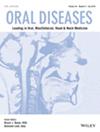针灸方法对颞下颌关节紊乱的影响比较:网络荟萃分析
IF 2.9
3区 医学
Q1 DENTISTRY, ORAL SURGERY & MEDICINE
引用次数: 0
摘要
材料与方法 在Cochrane、PubMed、Embase和Web of Science等英文数据库,以及CNKI、万方和VIP等中文数据库中检索有关针灸对TMD影响的随机对照试验,检索截止日期为2024年1月21日。数据分析采用 R 软件和贝叶斯法。结果分析共纳入 35 篇文章,涉及 1937 名 TMD 患者。NMA结果表明,DN-PT在缓解疼痛和改善张口情况方面效果最佳。(结论根据现有证据,NMA 结果表明 DN-PT 对缓解 TMD 疼痛和改善张口效果最佳。然而,由于某些针灸疗法仅在少数研究报告中有所报道,这可能会导致结果的随机性增加,可靠性降低。本文章由计算机程序翻译,如有差异,请以英文原文为准。
Comparison of the effects of acupuncture methods on the temporomandibular disorder: A network meta‐analysis
ObjectivesA network meta‐analysis (NMA) was applied to compare the therapeutic effect of different acupuncture methods on temporomandibular disorder (TMD).Materials and MethodsA computer retrieval was carried out in the English databases of Cochrane, PubMed, Embase and Web of Science, as well as the Chinese databases of CNKI, Wanfang and VIP for randomized controlled trials on the effect of acupuncture on TMD, with a retrieval deadline of January 21, 2024. Data analysis was conducted using R software and Bayesian method. The pain score served as the primary outcome measure, with the mouth opening as the secondary outcome measure.ResultsThirty‐five articles were included in the analysis, involving 1937 TMD patients. The NMA results suggested that DN‐PT had the best effect on relieving pain and improving mouth opening. (Description of all abbreviations in Supplementary Material S3).ConclusionsBased on the available evidence, the results of the NMA suggest that DN‐PT is most effective in relieving TMD pain and increasing mouth opening. However, due to the fact that some acupuncture therapies are only reported in a small number of research reports, this may lead to an increase in the randomness of the results and a decrease in the reliability.
求助全文
通过发布文献求助,成功后即可免费获取论文全文。
去求助
来源期刊

Oral diseases
医学-牙科与口腔外科
CiteScore
7.60
自引率
5.30%
发文量
325
审稿时长
4-8 weeks
期刊介绍:
Oral Diseases is a multidisciplinary and international journal with a focus on head and neck disorders, edited by leaders in the field, Professor Giovanni Lodi (Editor-in-Chief, Milan, Italy), Professor Stefano Petti (Deputy Editor, Rome, Italy) and Associate Professor Gulshan Sunavala-Dossabhoy (Deputy Editor, Shreveport, LA, USA). The journal is pre-eminent in oral medicine. Oral Diseases specifically strives to link often-isolated areas of dentistry and medicine through broad-based scholarship that includes well-designed and controlled clinical research, analytical epidemiology, and the translation of basic science in pre-clinical studies. The journal typically publishes articles relevant to many related medical specialties including especially dermatology, gastroenterology, hematology, immunology, infectious diseases, neuropsychiatry, oncology and otolaryngology. The essential requirement is that all submitted research is hypothesis-driven, with significant positive and negative results both welcomed. Equal publication emphasis is placed on etiology, pathogenesis, diagnosis, prevention and treatment.
 求助内容:
求助内容: 应助结果提醒方式:
应助结果提醒方式:


